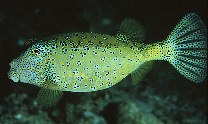|
Ostracion cubicum Linnaeus, 1758 Yellow boxfish |

|
|
photo by
Randall, J.E. |
| Family: | Ostraciidae (Boxfishes) | |||
| Max. size: | 45 cm TL (male/unsexed) | |||
| Environment: | reef-associated; marine; depth range 1 - 280 m | |||
| Distribution: | Indo-Pacific: Persian Gulf (Ref.80050), Red Sea and East Africa (Ref. 3141) to the Hawaiian and Tuamoto islands, north to Ryukyu Islands, south to Lord Howe Island. The Red Sea population differs slightly in coloration and has been known as Ostracion argus. Closely related to Ostracion immaculatum from southern Japan. Southeast Atlantic: south coast of South Africa (Ref. 3141). |
|||
| Diagnosis: | Dorsal spines (total): 0-0; Dorsal soft rays (total): 8-9; Anal spines: 0-0; Anal soft rays: 9-9. Caudal fin rays 10. Juveniles bright yellow with black spots; the spots decrease proportionately and the bright yellow becomes a dirty mustard with growth; large adults become bluish with yellowish seams between the plates. Description: Characterized further by adults having numerous black spots on fins; juvenile with scattered black spots on head and body; carapace quadrangular in cross section, concave sides, broader at base than dorsally; more or less straight dorsal profile of snout, presence of bony protuberance above upper lip (absent in juvenile); rounded caudal fin (Ref. 90102). | |||
| Biology: | Inhabit lagoon and semi-sheltered seaward reefs. Juveniles often among Acropora corals (Ref. 9710). Benthopelagic (Ref. 58302). Solitary (Ref. 5503). Juveniles expatriating to subtropical zone from the pelagic larval stage. Small juveniles secretive in narrow crevices (Ref. 48637). Feed primarily on algae with a compliment of microorganisms, invertebrates, mollusks, sponges (Ref. 5503), sand dwelling polychaetes, crustaceans, foraminiferans, and fishes (Ref. 37816). | |||
| IUCN Red List Status: | Least Concern (LC); Date assessed: 18 August 2023 Ref. (130435) | |||
| Threat to humans: | harmless | |||